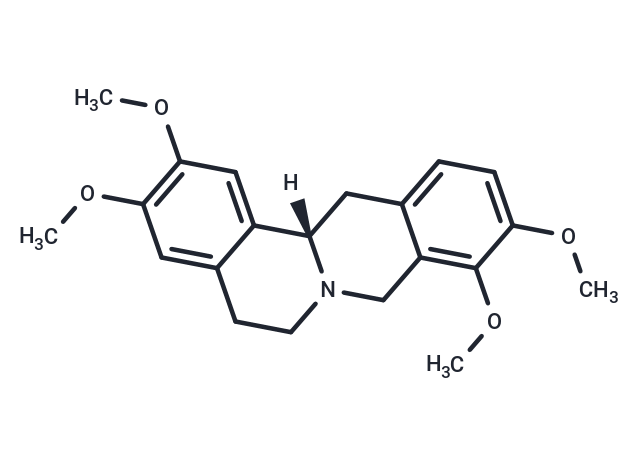Shopping Cart
Remove All Your shopping cart is currently empty
Your shopping cart is currently empty
Rotundine (Gindarine) (L-tetrahydropalmatine, L-THP) is a selective dopamine D1 receptor antagonist with IC50 of 166 nM.

| Pack Size | Price | USA Warehouse | Global Warehouse | Quantity |
|---|---|---|---|---|
| 50 mg | $31 | In Stock | In Stock | |
| 100 mg | $44 | In Stock | In Stock | |
| 500 mg | $98 | In Stock | In Stock | |
| 1 g | $148 | In Stock | In Stock |
| Description | Rotundine (Gindarine) (L-tetrahydropalmatine, L-THP) is a selective dopamine D1 receptor antagonist with IC50 of 166 nM. |
| Targets&IC50 | D3 receptor:3300 nM, D1 receptor:166 nM, 5-HT1A receptor:370 nM, D2 Receptor:1400 nM |
| In vitro | Cidofovir inhibits human cytomegalovirus (HCMV) infection in cultured cells. Cidofovir is inhibitory to CMV plaque formation even when added to the cells at 48 hr post infection with IC50 of 0.9 μg/mL for Davis and 1.6 μg/mL for AD-169 strains,respectively. [1] Cidofovir also inhibits herpes simplex virus infection. In addition, Cidofovir blocks cell fusion induced by HSV-1 in monkey kidney cells and blocks the expression of HSV-l-specific proteins and the synthesis of viral DNA. [3] |
| Synonyms | L-Tetrahydropalmatine, Gindarine, Caseanine, (-)-Tetrahydropalmatine |
| Molecular Weight | 355.43 |
| Formula | C21H25NO4 |
| Cas No. | 483-14-7 |
| Smiles | O(C)C=1C=C2[C@]3(N(CC=4C(C3)=CC=C(OC)C4OC)CCC2=CC1OC)[H] |
| Relative Density. | 1.23 g/cm3 (Predicted) |
| Storage | Powder: -20°C for 3 years | In solvent: -80°C for 1 year | Shipping with blue ice/Shipping at ambient temperature. | |||||||||||||||||||||||||||||||||||
| Solubility Information | DMSO: 55 mg/mL (154.74 mM), Sonication is recommended. H2O: < 1 mg/mL (insoluble or slightly soluble) Ethanol: < 1 mg/mL (insoluble or slightly soluble) | |||||||||||||||||||||||||||||||||||
Solution Preparation Table | ||||||||||||||||||||||||||||||||||||
DMSO
| ||||||||||||||||||||||||||||||||||||
| Size | Quantity | Unit Price | Amount | Operation |
|---|

Copyright © 2015-2025 TargetMol Chemicals Inc. All Rights Reserved.